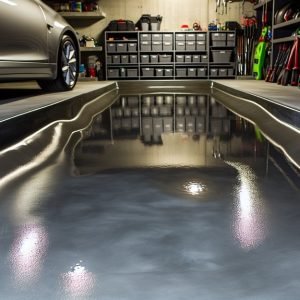Last Updated on November 12, 2025 by teamobn
When it comes to protecting your garage from moisture, understanding the importance of drainage and proper flooring slopes is essential. You might not realize how a slight incline can greatly impact water flow and prevent pooling. Even small cracks can lead to major issues if left unchecked. By taking proactive steps, you can safeguard your space from water intrusion and maintain its functionality. But what specific measures should you consider to guarantee long-term protection?
Contents
Importance of Garage Drainage
Garage drainage is necessary for maintaining a dry and functional space, especially if you frequently park vehicles or store equipment. Proper drainage prevents water accumulation that can lead to structural damage, mold growth, and rusting of metal surfaces.
With effective drainage, you can manage rainwater runoff and minimize the risks associated with excessive moisture. A well-designed drainage system directs water away from your garage and foundation. This system may include floor drains, trench drains, or drain tiles, which efficiently channel water outside.
If you notice standing water, it’s important to assess your drainage setup and identify any blockages or inefficiencies. Regular maintenance of the drainage system, including cleaning out debris and confirming proper slope, is essential for peak performance.
In addition to protecting your garage, effective drainage enhances the longevity of stored items and vehicles. It also reduces slip hazards during wet conditions.
Understanding Flooring Slopes
When it comes to effective drainage, understanding flooring slopes is important for directing water away from your garage. A well-designed slope facilitates the natural flow of water towards drains or lower areas, preventing pooling and potential damage.
Ideally, your garage floor should slope at least 1% to 2% away from your foundation, guaranteeing adequate drainage.
To achieve this, consider the materials used during installation. Concrete is commonly used, but it’s essential to pour it with the correct gradient. If you’re retrofitting an existing garage, you might need to raise the floor or install a drainage system that accommodates the slope.
You should also assess the surrounding landscape. Verify that the exterior grading slopes away from the garage to complement your flooring slope. Any impediments, such as landscaping or structures, can hinder water flow and negate your drainage efforts.
Regular maintenance is critical. Inspect the drains for clogs and verify that debris doesn’t obstruct the slope.
Common Causes of Water Intrusion
Water intrusion can stem from various sources, often leading to significant damage if not addressed promptly.
You might be surprised to learn how easily water can penetrate your garage, creating an environment ripe for mold, mildew, and structural damage.
Here are some common causes you should be aware of:
- Poor drainage systems: Ineffective drainage can cause water to pool around your garage’s foundation.
- Cracks in walls and floors: Small fissures may seem inconsequential but can allow water to seep in over time.
- Roof leaks: Damaged or missing shingles can lead to water runoff that seeps into your garage.
- High groundwater levels: When the water table rises, it can exert pressure against your garage’s foundation, leading to intrusion.
Effective Drainage Solutions
Implementing effective drainage solutions is vital for preventing water intrusion and protecting your garage from moisture-related issues.
Start by evaluating the existing drainage system. Verify downspouts are properly directed away from the garage. Extensions can be used to lead water at least six feet away from the foundation.
Consider installing a French drain around the perimeter of your garage. This system collects groundwater and redirects it, minimizing the risk of pooling. Confirm the drain is sloped appropriately to facilitate water flow.
Additionally, you might explore sump pumps, especially if your area is prone to heavy rainfall. These pumps can actively remove water that accumulates in low areas of the garage. Regular maintenance is important; check the pump’s functionality and clean any debris that may obstruct drainage.
If you’re experiencing consistent issues, a professional evaluation can provide tailored solutions.
Review the grading around your property as well; it should slope away from the garage to promote effective drainage.
Designing Proper Floor Slopes
Properly designed floor slopes in your garage are crucial for effective drainage and moisture control. If your floor isn’t sloped correctly, water can accumulate, leading to potential damage and costly repairs. To guarantee ideal drainage, you should aim for a slope of at least 1% (or 1/8 inch per foot) towards your floor drain.
Consider these important factors when designing your floor slopes:
- Prevention of water pooling: Avoid stagnant water that can foster mold and mildew.
- Protection of your belongings: Keep your tools and equipment safe from water damage.
- Enhanced durability: Reduce the risk of concrete deterioration over time.
- Improved safety: Minimize slip hazards caused by wet surfaces.
When planning your garage floor, it’s essential to assess existing structures, such as walls or support beams, that may influence your drainage design.
Remember to consult with professionals if you’re uncertain about the correct slope ratios or drainage placements. A well-designed floor slope not only protects your space but also guarantees a more functional and safer environment for your activities.
Prioritize this aspect during your garage construction or renovation to secure long-term benefits.
Identifying Moisture Problems
Moisture issues in your garage can lead to significant structural damage and health risks if not identified early. To effectively pinpoint these problems, start by inspecting the walls, floor, and ceiling for any visible signs of moisture, such as stains, mold, or mildew.
Pay particular attention to corners, seams, and areas around windows and doors, which are common leak points.
Next, assess the garage’s ventilation. Poor airflow can exacerbate humidity issues, leading to condensation. Use a hygrometer to measure humidity levels; ideally, they should remain below 60%. If your garage feels damp or musty, it’s a clear indicator of moisture problems.
Check for any cracks in the foundation or slab where water can seep in. Inspect drainage systems, ensuring they’re functioning correctly and diverting water away from the garage.
If you notice excessive water pooling around the exterior, it’s essential to address the grading of the surrounding landscape.
Lastly, look for rust on metal tools or equipment, which can indicate prolonged exposure to moisture. By identifying these issues promptly, you can take necessary actions to mitigate risks and protect your garage space.
Maintenance Tips for Garages
While you might think of your garage as just a storage space, regular maintenance is essential to guarantee it remains a safe and functional area.
Neglecting this critical space can lead to moisture issues, pests, and safety hazards. Here are some maintenance tips to keep your garage in top shape:
- Inspect for leaks: Regularly check for any signs of water intrusion, especially after heavy rains. Also, be mindful of activities like washing your car inside the garage, since excess water can affect drainage and increase maintenance needs compared to the cost of car washed at home by professionals.
- Clear debris: Keep gutters and drainage systems clear to prevent overflow and flooding.
- Organize storage: Use shelves and bins to keep items off the floor and reduce clutter.
- Seal cracks: Fill any cracks in walls and floors to prevent moisture entry and enhance insulation.
Long-Term Protection Strategies
To effectively safeguard your garage against long-term moisture and drainage issues, implementing proactive strategies is essential.
Start by ensuring proper grading around your garage. This allows water to flow away from the foundation, reducing the risk of pooling and seepage. Installing a drainage system, such as French drains or channel drains, can effectively manage excess water.
Next, consider waterproofing your garage floor. Applying a high-quality sealant can prevent moisture penetration and protect against stains and deterioration.
Additionally, check your gutters and downspouts regularly. Make sure they’re clear of debris and direct water away from the structure.
It’s also wise to invest in a dehumidifier if humidity levels are consistently high. This helps maintain ideal moisture levels and prevents mold growth.
Conclusion
By prioritizing effective garage drainage and proper flooring slopes, you can greatly reduce the risk of moisture intrusion. Curiously, a well-maintained garage not only protects your belongings but also enhances your home’s value. Regular inspections and maintenance can uncover hidden issues before they escalate. So, while it might seem like a small detail, the right drainage solutions can lead to big benefits. Don’t wait for water damage to catch you off guard—take action now to safeguard your space.






